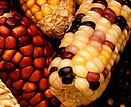 |
 |
|||||||||
|
Grain of Hope By Gordon Conway Gordon Conway, president of the Rockefeller Foundation, writes that advances in the genetic modification of rice may lead to a variety which helps to alleviate vitamin deficiency in developing countries Greenpeace calls "golden" rice fools' gold but many scientists and nutritionists believe it could save millions of people`s lives. It is a type of rice into which genes for beta-carotene have been inserted - and it is being made to carry a crushing load of ideological baggage in the GM debate. These tiny grains reflect the worst sides of the participants. Basic facts are not in dispute. More than 100m children worldwide are affected by vitamin A deficiency. As a consequence, 2m children die each year and 500,000 go permanently blind. They are from the poorest families in the developing countries, with little or no access to the balanced diets we enjoy in the industrialised world. The chart shows the size of the problem in Asia. There, poor families consume rice as a staple; babies are often weaned on rice gruel. But the rice grain lacks beta-carotene, the precursor of vitamin A. There is plenty in the leaves and stems, but none in the grain endosperm. And no amount of traditional breeding has been able to get it there. (Brown, unmilled rice contains only minute amounts of beta-carotene.) That has now changed as a result of the work of Ingo Potrykus of the Swiss Federal Institute of Technology. His team has been able to transfer two daffodil and one bacterial gene into rice that will ensure the rice grain contains beta-carotene. It is a classic piece of genetic modification, and that is why the anti-GM activists are so strident in their condemnation. The food industry, which had no part in its development, is also using golden rice for its own ends. It has featured the golden grains as part of a $50m campaign to promote GM foods. The message is that GM is not just about profits, it can save children`s lives. Conway says that all of this hype is premature and dangerous. The science that led us to golden rice is at a very early stage. Until the product is fully developed and tested, no one can be sure how well it will work and whether there may be unwanted side effects. Nor can many of the other promising applications - adding more nutrition to basic staple crops, such as cowpeas and sweet potatoes - be pursued. But some anti-GM activists would like the work to be stopped before we know its real value and are going to extraordinary lengths to rubbish the science Much play has been made of the amounts of rice people would have to eat to gain a full day's supply of vitamin A. But this misses the point that it is a deficiency we have to tackle, not a total lack of vitamin A. No one is suggesting rice should be the only source of vitamin A. Children die or go blind because they do not get enough. The first golden rice varieties, which will be improved, should provide enough beta-carotene to meet 10%-20% of the dietary requirements of a child. In many instances this will keep a child alive. This all sounds worthwhile but, says the opposition, it is a quick fix. We should be working instead on the causes of malnutrition. Of course we are working on those, but changing people`s livelihoods and farming patterns takes time. And in the meantime, millions will die or go blind. The insistence on focusing on fundamentals is also in consistent, if not downright hypocritical. Conway says that at the Rockefeller Foundation, we are also funding the development of vaccines against HIV in Africa (the first ones are currently being tested in Kenya). Should we stop all efforts at this and devote our funds solely to the attempt to change sexual behaviour or wait until the fundamental problem underlying the Aids epidemic - grinding poverty - is eliminated? There are alternative ways of dealing with vitamin A deficiency. They are all being tried (we fund some of them), but they all have drawbacks. Giving children twice yearly massive doses of vitamin A in tablet form will greatly reduce mortality. Several countries are doing this, but it is relatively costly and the poorest children are difficult to reach. Also, the mortality rate can be further reduced if, instead of massive doses, children are given smaller doses every day. Ideally farmers should cultivate diverse kitchen gardens, but in many regions they have to cope with long dry spells during which there are few fruits or vegetables. Besides, researchers have recently found that the beta-carotene available in green, leafy vegetables is much less than previously supposed. The best sources of vitamin A are animal products - butter, cheese, eggs, liver - but they are often out of reach for the poor. While nutritionists disagree on the relative merits of better diets, supplements or fortification, they agree that some combination is needed and multiple tools must be brought to the task. But before Golden Rice can be part of the solution we do need more answers
to the questions raised by anti-GM activists: answers which careful testing
can safely provide. First, we need to ensure the grain is freely available
to the poor and that it is acceptable; second, that there are no serious
environmental consequences from growing golden rice and third, that there
are no adverse effects on health. There is no hazard in ingesting excess
beta-carotene but we should watch for possible allergies. The potential
for saving lives is there and this makes it a moral imperative to seek
out the answers. That is why Conway says he welcomes the recent statement
by Benedikt Haerlin of Greenpeace that they will not disrupt testing and
he hopes that other anti-GM activists will give up a good campaign icon
for the sake of hungry children. |
|